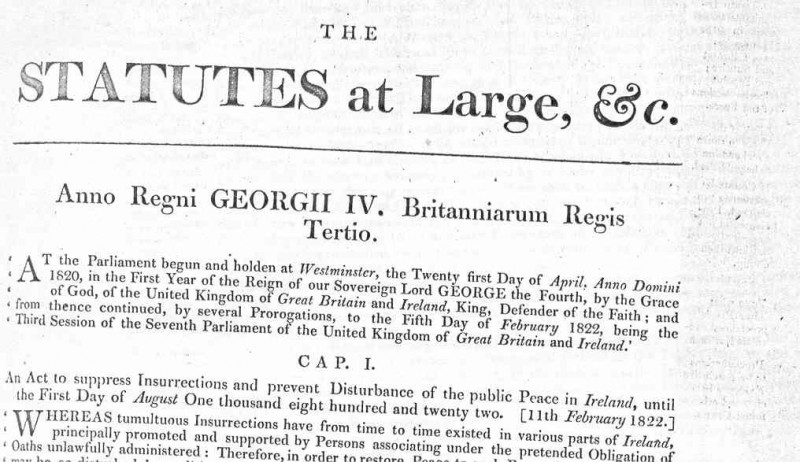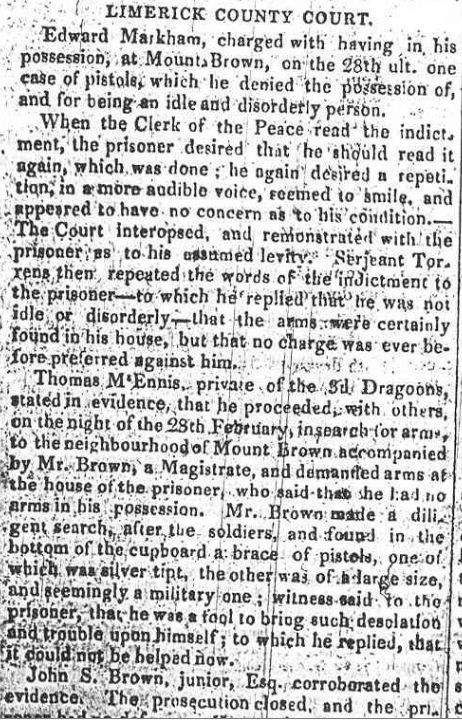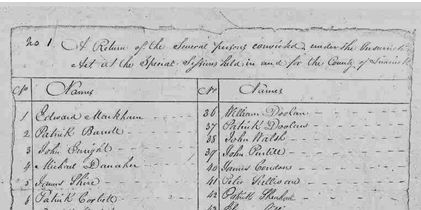These notes , in some respects, duplicate material on other website pages, but having been used as the basis of a talk on the Act, are included here for background information.
.
.
The full text of the Insurrection Act 1822 can be found here.
.
.
NOTES PART ONE – PRIOR TO THE INSURRECTION ACT.
- Insurrection Act of 1796 was re-imposed in 1802-03, 1807-09 and 1814;
- Martial Law from 1803-05;
- About 14 different coercian Acts during the decade;
- In the period 1800-15, habeas corpus was almost continuously suspended.
But repressive measures produced greater resistance
- secret societies – Whiteboys, Ribbonmen, Rockites etc – became the central forces in sustaining Irish violence:
- members beat up landlords and the proctors who collected the tithes.
- they meted out brutal punishment, including to Catholics, and they themselves were brutally dealt with when caught.
.
NOTES PART TWO – STATISTICS
Overall, about 30,000 men and 9,000 women were transported directly from Ireland…………. 179 under the Insurrection Act of 1822.
- Apart from those from the cities of Dublin and Cork, the majority were from rural areas and were first offenders.
- Thus not felons, but guilty of a crime only in a technical sense, nationalists fighting British domination, and social rebels protesting against a harsh and unjust law which condemned them to poverty and starvation.
- Officials testified that in general the country people were surprisingly honest.
[A G L Shaw]
.
“… the general character of the Irish convicts differs widely from that of other convicts. Their crimes for the most part are not the result of habitual profligacy and vicious contamination. They are not hardened offenders……nor are they usually found associated in gangs under experienced leaders for the commission of great and well-planned crimes. The offences of the Irish convicts are usually thefts to which they are often driven by distress.”
[The Lord Lieutenant of Ireland 1850]
.
NOTES PART THREE – UNREST IN CO. LIMERICK.
Late 1821 and early 1822
- “…murder of Mr Going in Limerick. “attacked by 4 men, 3 dressed in white, fourth was not disguised. His body was made a riddle of. They did not take his money.” [TIMES 22 Oct 1821]
- “It appears that a small party of troops proceeding through a village, were so violently assaulted by the people coming out of their chapel, as to render it necessary to fire in self defence.” [TIMES 27 Dec 1821]
- “…. has been in a very disturbed state; that a very general attack has been made on the houses of several farmers, all of which have been robbed of arms or money.” [Lord Wellesley 18 Jan 1822]
- The spirit of the peasantry is hourly becoming worse. Robbery is rife under pretence of levying funds for ‘the cause’. Various burnings between Rathkeale and Charleville. [Lord Wellesley 31 Jan 1822]
- .
- “….. the Ministers of their own religion have failed to produce any salutary effect on the hearts of these debased and deluded men.” [Magistrates 26 Feb 1822 petitioning for Promulgation of the Act.]
.
NOTES PART FOUR – GRIEVANCES.
- Enclosure of the town and village commons..loss of access rights;
- Excessive rents; Insecure tenure; Eviction from land;
- Low wages;
and especially…
- Imposition – on the overwhelmingly Catholic peasantry – of the hated tithes to be paid to the Established Church.
The above in the context of continuous poverty in the countryside, including failure from time to time of the potato crops.
NOTES PART FIVE – PARTIAL FAMINES IN 1817 and 1822.
Poverty in the countryside 1822.
- “The late heavy rains have produced the most ruinous consequences upon the potato crops; and typhus, the usual result of any extraordinary scarcity in an impoverished country, has made its appearance.” [TIMES 26 Dec 1821.]
- “Distress among the poorer classes and unprecedented price of potatoes.” [Major Wilcocks to Lord Wellesley 23 Jan 1822]
- “The distress of the poorer class in this neighbourhood is beyond description. The severe weather has caused the loss of almost all their turf and they are cutting down orchards etc for fuel. [Wilcocks and Lloyd to Lord Wellesley 28 Jan 1822]
- “It is monstrous that a public Minister …. abandons … the higher duty of protection to the King’s unhappy subjects – protection from the most terrible calamities- even those of nakedness and famine.” [(London)TIMES 11 Feb 1822]
NOTES PAGE SIX – The INSURRECTION ACT 1822.
The Act is referred to as the “Insurrection Act, Ireland” or commonly as the “Irish Insurrection Act” of 1822
- But it is not an “Irish” Act, rather an Act of the British Parliament.
Britain governed Ireland from Dublin Castle. Its appointee at the time as Lord Lieutenant of Ireland was Lord Wellesley
- oldest brother of the Duke of Wellington
The British Army had 16,000 soldiers in Ireland at the time.
.
NOTES PART SEVEN – DEFINITION IN THE ACT AS “IDLE and DISORDERLY”
- “….out of his or her Dwelling or Place of Abode from one hour after sunset until sunrise…”;
- “…administering or taking Oaths for seditious purposes…”;
- “…circulating a Notice, Letter or Message to excite Riots, threatening any violence, or demanding money, arms, weapons…”
- “…having arms or ammunition, Pike, Pike head, Spear or other offensive weapons…”
- “…assembled, not being inmates or travellers, in a Public House between 9 pm and 6 am…
NB. More serious crimes were dealt with under various other Acts with more severe penalties.
.
NOTES PART EIGHT – SEVEN YEARS, NO MORE, NO LESS.
All persons…
….idle and disorderly….
…transported for seven years.
Suspension of jury system, and NO right of appeal….
.
NOTES PART NINE – CRITICISM OF THE 1822 ACT BY THE TIMES.
…… yet it is from amongst these very (landholders, etc), .. that are to be found the magistrates appointed by this Insurrection Act to try and sentence their own personal enemies. How, then, is that law likely to be administered, which makes both Judge and juror of.. (the magistrate)? [TIMES 11 Feb 1822]
As was Dublin’s Judge Blacker
- “…The Insurrection Act suspended ‘a beautiful part of the Constitution’ when it made a man’s absence from his house at night prima facie evidence of his guilt; (or) magistrates could enter one’s house…” [Dublin Evening Post 1 Oct 1822]
Nevertheless magistrates seem to have been moderate in the use of their powers:
- During the 1822 – 1824 period of the Insurrection Act of 1822:
- Of 4000 arrests, only 507 convictions, 452 transported,
- Including Limerick: Of 785 arrests, only 181 convictions, 179 transported.
But many were transported “…on the strength of rumours, suspicions and underhand swearing.” [Manchester Guardian]
.
NOTES PART TEN – IMMEDIATE TRANSFER FOR TRANSPORTATION.
Consequently…
Immediate transfer from the court in Limerick to the gaol or hulk in Cove of Cork…
Example: First trial, the day after promulgation of the Act…
“….….even while the sentence of the Court was pronouncing …..placed on two carts at the courthouse door, ……they were instantly forwarded to Cork to be put on board the hulks for transportation agreeable to sentence.” [Limerick Chronicle 1 March 1822]
Magistrates had no role in setting destinations for transportees.
….personal view of Magistrate that the Colony of New South Wales provided too easy a life. He said:
: “….that a report had been currently circulated that New South Wales was a comfortable place to be transported to, but the Prisoner would find, and the Public may be assured, that an Island not so comfortable would be selected by the Government.” [Limerick Chronicle 3 March, 1822]
Not all transportees left Ireland. And some went to hulks in Bermuda.
Newspapers generally reported on all “unrest” cases.
This example:
.
NOTES PART ELEVEN – PRIOR TO BOARDING SHIPS.
Prior to boarding, where were convicts held?
- There was a Hulk “Surprise” at Cork or Cove at the time;
- But perhaps a gaol in Cork? A “Convict Depot”?
- On 10 May 49 “Insurrection Act” convicts – previously lodged in the convict depot – were transferred by water from Cork to Cove to go on board (‘Mangles’). [Dublin Freeman’s Journal 11 May 1822]
The Act, passed in the UK parliament on 11 February, was promulgated for Co. Limerick on 28 February 1822
First arrests that day and early hours of the next morning …3 a.m.
- Entered houses
Some were arrested for activities in the previous week…unlawful assembly..
- Major Wilcocks “…delayed taking any steps …knowing that in a few days the Insurrection Act would be in force…”
Out of homes at night…
.
NOTES PART TWELVE – EARLY ARRESTS AND CONVICTIONS.
[Mr Sergeant Torrens – magistrate, written 5 March, 1822 from Limerick – to Lord Wellesley].
{Extracted from British Parliamentary Papers.]
Rathkeale 2 March, 1822: “… this day three other convictions under the Insurrection law…one above lower class…Michael Carroll, the son of a very wealthy farmer.He was apprehended on Friday night.Session will sit in Rathkeale on Tuesday next where I hope I have some good cases for investigation. I have no doubt that many useful examples will be made under this law.
Thomas Shaughnessy and (the elderly) Mortough Sullivan, convicted for being idle and disorderly persons under the Act, having been out of their homes at half past ten o’clock on the night of the 28th ult (when an incident relating to the burning of a house at Adare occurred); as well as Michael Carroll.”
Rathkeale. 5 March, 1822: “Special Session opened here this day…three convictions for district offences – James Roche for having arms and ammunition on his person in a street of Rathkeale after denial and also a threatening notice signed General Rock; William Nix for being found out upon a highway after hours, and David Donovan for being absent from his own home….”
Rathkeale. 6 March, 1822: “…..three other persons….. under the Insurrection Law…John Hickey, Thomas Driscoll and Michael Neill. We sent off the convicts to Cork this day, immediately sentence was pronounced, which had a most imposing effect upon a multitude of spectators.”
[NOTE: Shaughnessy and Edmund Markham were both on the Mangles and were assigned on arrival in NSW to James Byrne in Appin (near Campbelltown). Their sons, who each married a Walsh sister, became lifelong friends. Edmund and his wife, Bridget, were witnesses at the Shaughnessy son’s wedding. See the latter’s diary for further references.]
NOTES PART THIRTEEN – CONVICTIONS
RETURN of prisoners convicted in Co. Limerick under Special Sessions (Insurrection Act):
- 51 names – between 1 March and 4 April
NOTES PART FOURTEEN – BRITISH PARLIAMENTARY PAPERS STATISTICS.
STATISTICS RE INSURRECTION ACT.
785 arrests in Co. Limerick – 1822 to 1824.
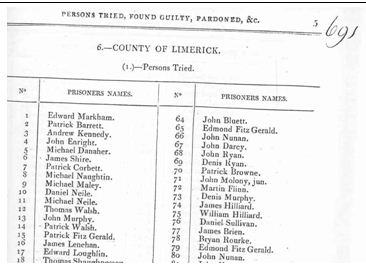
BPP 1822 (XIV) pp. 787, 790/791 IN NLA. And now Enhanced BPP on Ireland 1801-1922 (EPPI) on the Internet.
- 173 Convictions. All transported.
But many were acquitted. This example Page 238 Ireland.
Commitments etc under the Insurrection Act from January 1, 1823 – 1 February, 1824:
[table “” not found /]
NOTES PART FIFTEEN – PETITION TO LORD WELLESLEY JUNE 1822
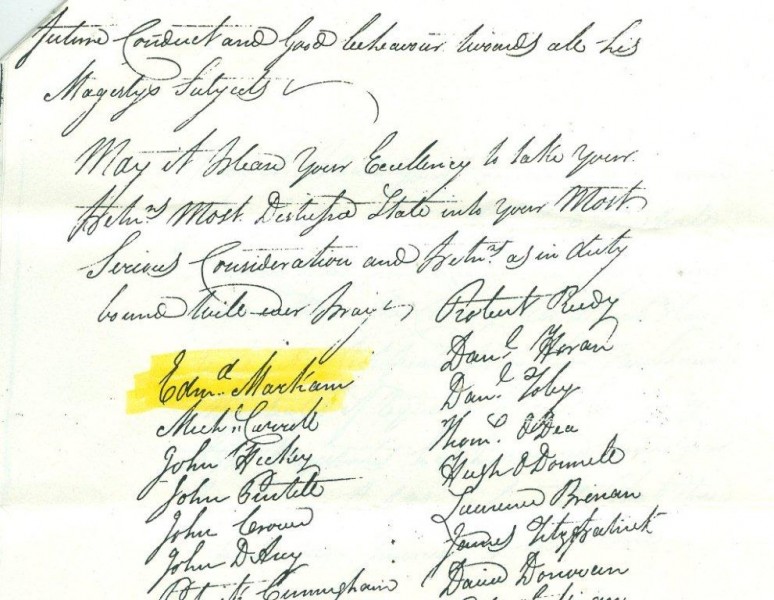
Portion of the Petition of several ‘Mangles’ transportees to the Lord Lieutenant Wellesly. [SOURCE: State Paper Office Dublin. Petition 1771 June 1822.
PETITION to Lord Wellesly BY 30 transportees..
Claimed that they were …..‘innocent’ , …”..banished from their native country and their poor distressed families…” , “…will take oath of allegiance… and become loyal subjects…”
Margin Notation by Lord Wellesly : “Refer to Judge who tried the prisoners, through Mr Gregory. Signed “W”.
The Petition failed.
.
NOTES PART SIXTEEN – “MANGLES”.
An example of an Indent, of names, convictions and personal detail, is shown elsewhere on this website.
Click on ‘”MANGLES 1822“.
- Ship 594t. Built Bengal 1802. J. Coghill Master.
- The Mangles made 9 trips to Australia. The only ship to make more trips was the Surrey, which made 11 trips.
- Second Voyage 1822 189 convicts
- 113 of the 189 men on the Mangles in 1822 were ‘ploughman’ or ‘reaper’,
- 34 of the 43 Co Limerick Insurrection Act convicts on board were similarly described.
- Despite departure set for late June, boarding commenced in late April.
- The surgeon reported that:
“several of the convicts are complaining of various ailments, some of which to be real, and others feigned, with a view to being sent back to the convict depot. [Surgeon Reports AJCP records on microfilm in NLA.]
.
.NOTES PART SEVENTEEN – TRANSPORTATION ON THE “MANGLES”
· Cove of Cork 21.6.1822 – Rio – Port Jackson 8.11.1822.
- THE SHIP’S HISTORY.
[Log of Logs, Arrivals in NSW, and ‘THE CONVICT SHIPS’ pp. 214-217 by Bateson – all in NLA.]
- SURGEON’S LETTER OF RECEIPT OF CONVICTS.
[Reel AO2424 in NLA and NSW ARCHIVES]
- LORD LIEUTENANT’S INDENT Signed at His Majesty’s Castle, DUBLIN 19 June 1822.
[Reel AO2749 in NSW ARCHIVES.]
- SHIP’S INDENT DELIVERED IN NSW.
[COD 151 pp.203 – 216 in NSW ARCHIVES.]
- SURGEON SUPERINTENDENT REPORT OF THE JOURNEY.
(AMD 101/47 PRO Reel 3202 in NLA.)
- ASSIGNMENT OF 117 MEN ON ARRIVAL PORT JACKSON.
[Reel 6009 in NLA AND NSW ARCHIVES.]
To return to ‘Ireland and 1820s Insurrection, click here.
